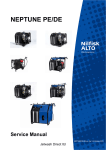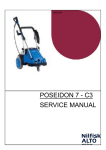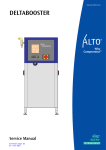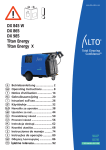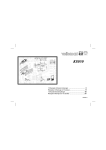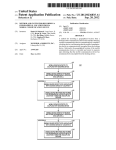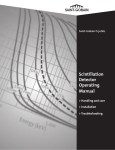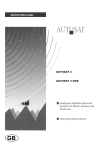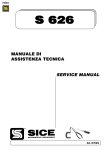Download Alto Contractor Diesel Repair manual
Transcript
www.alto-online.com 125 03 47 (03.2003) CONTRACTOR DIESEL Repair Manual 2003-11-14 ALTO Danmark A/S Industrikvarteret DK-9560 Hadsund Tel.: +45 7218 2100 www.alto-online.com Copyright © 2003 ALTO Danmark A/S A Technical data B Structure C Function D Trouble-shooting E Service / Repair F Test / Adjustment G El. diagrams H Spare parts proposal I (Info & spare parts) INDEX CONTRACTOR Diesel Petrol CONTRACTOR Diesel 4 Motor data Diesel motor RUGGERINI MD 151, S Engine type 4 stroke two cylinder Max. output at 3600 rpm 13 HP / continuous 12.3 HP Max. torque st 2400 rpm 3.26 Kgm Fuel consumption Approx. 3 l/h Fuel tank capacity 4.1 l Adjusted speed at max. pressure 3500±10 rpm Cooling system Forced air 700 m3/h Air requirement for combustion 62 m3/h PTO shaft rotation clockwise Max. vacuum intake 0.024 bar Max. exhaust backpressure 0.039 bar Engine oil capacity / type 1.8 l / SAE 15 - 50 Dry weight 50 kg A D_CON. 03GB. CONTRACTOR Diesel Pump data A Heavy Duty 210 bar 225 Pump pressure 180 bar / 2550 psi 205 Nozzle pressure 170 bar / 2410 psi 195 By-pass pressure 8 bar 10 Water quantity at min./max. pressure 20/19 l/min. 17.5/16 l/min. Water quantity at steam 9 l/min. 8 l/min. Pump pressure at steam 40 bar 30 bar High pressure nozzle 1506 = 1.35 mm 1505 Max. temperature of inlet water 35°C 35°C Inlet pressure, max. 10 bar 10 bar Chemical injector (external only) 03 injector / foam injector Density (control box) IP45 Engine r.p.m. (pump pressure) 1750 ± 25 r.p.m. Noise level according to ISO 3746 85 DB(A) from 7 m distance Type of piston Stainless steel Ceramic Wobble disc no. 7 3 Type of oil BP Bartran HV 100 125 03 47 - (03.2003) Opening pressure D_CON. 03GB. 5 CONTRACTOR Diesel Boiler data A Heavy Duty Boiler effect 6 115 kW 100 Water outlet temp. at max. water quantity (12°C) 95°C (205°F) = Oil consumption at max. water quantity and temp. 12 l/h 10 l/h CO2 10-12% = CO 50-100 ppm = Temp. flue gas at 20°C ambient temp. 160-200°C = Smoke scale number Max. 1 = Flue gas loss Max. 10% = Oil nozzle type 9 kg/h - 60°S = Oil pressure 12 bar 11 bar Boiler tube / measurements Welded st. 35.8 / 20 x 3mm x 48m Heating surface 3 m2 Quantity of inlet air Approx. 180 m3/h Outlet flue gas 260 m3/h at 200°C Tank capacity max./min. Jerry can 20 l / 3 l D_CON. 03GB. CONTRACTOR Diesel Electrical parts A A1 KEW-steering 24V AC 642009A A2 KEW-converter 12V DC / 24V AC 6420013 B1 Flow control After pump magnet oper. Reed-switch B2 Flow control Before boiler magn. oper. Reed-switch B4/B5 Temperature sensor PT500 B6 Flame sensor Light-sensitive transistor B67 Motor oil switch Open at a normal oil pressure F1 Fuse on print A2 1 AT F2 Fuse on print A2 *) 6.3 AT F3 Fuse for PC-board A1 (see page 5) 1.25 AT F4 Fuse for start protection (see page 5) 1.25 AT G1 Accumulator battery 12V min. 50 AH (300 Amp.) G2 Generator internal/external 12V - 15V - 280 Watt / 300 Watt G3 Regulator/Rectifier H1 Motor oil alarm Lamp on front H2 Starting relay Lamp on front M1 Starting motor 1.1 kW R1 Resistance (only where B5 is not used) 560 ohm S1 Start switch Key on front T1 Ignition transformer Prim: 2x12VAC/17 Amp. Sec. 11KV 125 03 47 - (03.2003) Y1 Magnet valve for oil pump 24 VAC F3 *) secure against fault polarization of battery D_CON. 03GB. 7 Setup Structure B The Contractor is constructed on a combined pipe and plate frame, surface coated with a strong polyester. Each single item of the machine is placed in a way that an optimum weight distribution is obtained taking service and operation into consideration. Temperature indicator Front panel Temperature regulation Ignition key Control lamps H1 H2 Starter battery Chemicals container rack Exhaust outlet from boiler Ignition transformer Electrics box Exhaust from motor Manometer for HP-pump Pump oil Diesel tank for motor Fuses F3 F4 Back of electrics box Motor suspension The base plate for the motor/pump unit is mounted on 4 inclined vibration absorbers. The boiler is mounted on a plate construction, which serves as air duct from blower to boiler. Electrics box is suspended in the pipe frame and contains the controlling and safety system of the machine 8 D_CON. 03GB. Setup Structure B Pump front Manometer Water quantity regulation Water inlet Water outlet Flow switch B1 Pressure outlet Electromagnet Y2 Y3 (safety stop) Sludge glass Starter relay Starting motor Gearbox Diesel oil for pump Motor connection (- pinch) Oil pressure switch B7 Rectifier G3 Motor air filter Blower Flow switch B2 Solenoid valve Y1 125 03 47 - (03.2003) Flexible coupling Fuel oil pump D_CON. 03GB. Air adjustment screw Flow switch B2 9 Boiler Structure B The boiler is the heat generating part of a hot water machine. It consists of a labyrinth-constructed tube coil, which encloses the combustion chamber. The tube coil is enclosed by a double container with boilerjacket, bottom, and top in a sandwich construction, between which the combustion air is pressed into the combustion. An insulating material placed in the bottom of the boiler makes sure that the inner bottom, among other things, is protected from superheating. Gasket Exhaust gas Electrodes Flame sensor Oil nozzle Flame tube top part Air distributor Burner tube Inner jacket Outer jacket Flame tube bottom part Insulating mat Air duct Water inlet Gasket Air inlet Water outlet A flame tube consisting of two rings has the purpose of securing that the hot exhaust gases are forced round the labyrinth of tubes. The boiler is mounted on the air duct with a gasket between and fastened with 3 bolts. In the air duct an adjustable throttle is mounted. 10 D_CON. 03GB. Pump B Structure The pump is a 4 cyl. axial pump model 03 with standard sealing system and steel pistons, or model C3 with textile seals and and ceramic pistons. The pump is driven by the motor through a gear, which reduces the number of revolutions of the spindle from 3500 rpm to 1750 rpm. Gear wheel Gasket Roller bearing Cylinder cover Oil glass Pistons Clamping ring Valve cylinder head Pressure valve By-pass valve Non return valve Pressure outlet Safety valve Suction valve Oil seal Wobble disc Oil seals Pressure seal Oil drain Suction seals Motor shaft Valve piston D-cover Oil drain Sludge container Standard HD C3 Drain channel WOBBLE DISC Standard HD No. 7 No. 3 Textile seal 125 03 47 - (03.2003) Oil seal Back-up seal D_CON. 03GB. 11 Operating diagram Function C When the Contractor is running, the fan draws in air and leads it through a channel with an air volume adjustment and into the bottom of the boiler, around and between the two jackets up to the air distributor. In this way the air is preheated, before it is mixed with the oil spray from the nozzle. Fuel nozzle Air distributor Fuel tank Fuel filter Fan Magnet valve Air in-take Fuel pump Max Insulation Air adjustment Oil pressure damper The fuel is drawn from the jerry can through the fuel filter to the pump, while in hot mode it is passed through the magnetic solenoid valve to the nozzle in the air distributor. The ignition transformer is active for approx 6 sec., and during this period it will form sparks between the electrodes. If the flame is not developed within this time, a flame sensor placed on top of the boiler will secure that the machine is automatically stopped. When the machine is running normally, and the boiler is burning normally, the flame is pressed against the insulated bottom. The temperature is here approx. 1100°C. The hot exhaust gas is pressed further round the labyrinth-shaped combustion chamber, where the heat is absorbed by the water flow in the tubes. 12 D_CON. 03GB. Operating diagram Function C The flow system is simple with direct water inlet to the pump (water tank can be mounted), on which an adjusting screw permits infinitely variable regulation of the water quantity. From the pump the water passes two flow controls, before it flows through the approx. 30 m pipe line of the boiler. On the outlet pipe the temperature sensors are placed (2 sensors are mounted, where priming safety is necessary). B5 Water inlet BOILER Water quantity regulation Y1 B3 Pressure water outlet B1 B7 B2 B4 Water outlet from the machine The flow switch detects whether there is water and thereby a flow in the system. If one of the flow switches disconnects because of a failing flow, the oil supply will be shut off after 4 seconds. B4, B7 temperature sensors The temperature sensors are PT500 elements sensing the water temperature at the outlet of the boiler. The function of the sensors is, in a cooperation with the electronics, to check the outlet temperature of the water compared to the preset value, see also page 12. B5 flame sensor The flame sensor is a light-sensitive transistor mounted at top of the boiler. Its function is to detect whether the flame is on. If the burner does not ignite, the engine will stop within approximately 5-10 sec. In order to start the engine again, turn the ignition key in position „off“. Y1 magnet valve On the fuel oil pump the magnet valve Y1 is controlling the injection of oil into the boiler and by that the temperature. Y1 opens to the fuel oil, when B1 and B2 are activated at the same time, and the temperature setting is higher than the actual water temperature on the outlet from the boiler. 125 03 47 - (03.2003) B1, B2 flow switch D_CON. 03GB. 13 Operating diagram Function C The controlling and safety system of the Contractor consists of the PC-board A1, the main task of which it is to secure operation and safety of the boiler system. The PC-board A2 is a conver ter, the main tasks of which it is to convert 12 V DC to 24 V AC and to supply the ignition transformer with 2x12V AC. A1 KEW control 12V DC/24V AC conver ter A2 A1 A2 Motor oil switch B7 F3 Fuse 1AT F1 F4 8 7 6 5 4 3 2 1 Fuse 6.3A F2 safe pump oil motor 24V Fuse 1.25AT F3 Fuse 10AT F4 Accumulator 12V G1 Generator G2 S6 Regulator / rectifier G3 Y1 Oil Pressure indicator H1 Boiler Charging indicator H2 Starting motor M1 Ohmic resistance T1 R1 A2 Start switch S6 12V DC from Accumulator S1/2 Y2 Y3 S3/4/5 2x12V AC to ignition trafo 9 Pole plug on A2 JP1 8/12 Pole plug on A1 X2/3 Charging plug X4 B7 Ignition trafo T1 Solenoid valve fuel Y1 G2 S6 Hold & Draw coil Y2/Y3 G3 12V Start Motor M1 Y3 When the motor is running, the generator G2 supplies 12 Volt DC to the conver ter A2, and the conver ter supplies 24 Volt DC to the control PC-board A1. The motor is automatically stopped at flame failure and at lack of lubricating oil in the motor. F1 F2 F3 F4 Fuse on A2 Fuse on A2 Fuse on El-box Fuse on El-box B7 Motor oil alert 14 secures the PC-board against too big charging rate secures against wrong polarization of battery secures A1 against overload secures A2 against overload at star ting of motor The motor oil alert is a pressure gauge mounted on the engine. Usually the pressure gauge is closed but at a normal oil pressure it will be open. If the engine runs dry of oil, the switch will close and thereby stop the engine. D_CON. 03GB. EL.-control Function C Plug for test box no. 6420100, see page 32. A1 08 SLOW 150 09 x2 8 7 6 5 4 3 2 1 Temperature range selector x2 safe pump 12 oil motor 24V 9 8 1 x3 x3 B5 B7 B4 B2 B1 The A1 PC-board is supplied with 24V AC from the conver ter PC-board A2, and it is controlling the oil injection (Y1) into the boiler with a 24V signal of X2, 4 and 5. This on/off signal is e.g. controlled by the flow controllers B1 and B2, which are each equipped with a Reed switch making contact when there is a flow through the machine. If both flow controllers are not making contact at the same time (max. time difference approx. 4 sec.), the signal for oil injection (Y1) will disconnect and close, until the machine is stopped and restarted. The temperature regulation is getting information from the temperature sensor B4 (PT500) placed in the outlet pipe from the boiler and from the adjustable potentiometer placed on the PC-board. The result is together with B1 and B2 controlling the signal for oil injection (Y1). A safety thermostat (priming safety) B7 is securing that the machine stops, if the temperature of the boiler outlet pipe exceeds approx. 173°C. On some machines this additional safety is replaced by a built-in resistance. 125 03 47 - (03.2003) The flame super vision circuit is connected to a light sensor B5 (X3.11 and X3.12) in the top of the boiler and stops the machine under the following conditions: a) If a flame has not occured within 5-10 sec. after the thermostat output has closed. b) If the flame disappears for more than 5-10 sec. while the thermostat output is closed. c) If the flame is present 15-30 sec after the thermostat output has opened. d) If a flame breaks out and stays for more than 15-30 sec. while the thermostat output is open. e) If the light sensor is short-circuited or disconnected. D_CON. 03GB. 15 EL.-control Function 1 KEW 6420013 JP1 2 Starting rev., 24VAC: Declutching rev., 24VAC: Temperature range: Securing of temperature - ignition transformer: C 2500 rpm ±10% 2300 rpm ±10% 0-65°C 3 Interrupts at 90°C ±5°C 4 5 6 7 8 9 F1 Connections: S1: +battery S2: -battery S3: ignition transformer S4: double wire ignition transformer S5: ignition transformer S5 S3 S4 F2 S1 S2 input from input from input from output to 6420009 output to input from output to input from input from 1 2 3 4 Pressure switch B7 Safe, X2-8 on 6420009 Pump, X2-6 on 6420009 24VAC (0), X2-2 on 5 6 7 8 9 24VAC (f), X2-1 on Key, +12V from key Engine off, Y2 on engine G2 on engine G2 on engine 1. The converter is supplied with 12-15 VDC. 2. The converter supplies the control unit 6420009 with 24 VAC/55 Hz, when the engine is running (rpm > 2500). 3. The conver ter supplies the ignition transformer with 2x12VAC, when the engine is running (rpm > 2500) and there is a signal on „Pump“. The ignition transformer is active for approximately 6 sec. If new signal displays within the 6 sec., the time will start all over again. 4. The conver ter is protected against polarization errors, i.e. a fuse (F2) will blow if the cables of the battery are interchanged. 5. The engine is stopped by a signal at the Safe inlet. Disconnect the conver ter (Key off) before restarting the engine. 6. The engine is stopped by a signal at the inlet of the pressure gauge. 7. The converter features an excess temperature cut-out breaking the voltage for the ignition transformer at a temperature > 90°C. Supply voltage: Outlets: Supply for KEW 6420009: Voltage for the ignition transformer: 16 12-15 VDC 24VAC ± 15% 0.5A 55Hz ± 15% 2x12VAC ± 15% 17A 100Hz ± 15% D_CON. 03GB. Electric system G1 G2 G3 M1 S6 Y3/Y2 B7 H1/H2 Function C 12V start battery 12V generator in motor charge rectifier start motor with relay start switch pull hold coil for the fuel supply of motor lubricating oil pressure switch for motor pilot lamps oil pressure and battery charger G3 G2 Switch 30/1 30 position 15 50 15/54 0 1 S6 start 15/54 H2 + - 30 30/1 15 50 Y3/Y2 H1 oil B7 G1 + M1 125 03 47 - (03.2003) When the ignition key in star ter switch S6 is turned into position 1, contact is made. 30/1 to 15 - by that H1 lights and contact is made. 30/1 to 15/54 - by that H2 lights. When the ignition key is turned into position “start”, contact is made. 30/1 to 50 - by that starter relay and starting motor are activated. At the same time the draw coil Y3 is activated, which is thereby opening for the fuel to the motor. The motor accelerates, and oil pressure switch B7 opens. The oil lamp H1 is switched off. At approx. 2000 r.p.m. the generator G2 takes over the power supply and activates the charge rectifier G3. By that H2 is turned out. D_CON. 03GB. 17 Pump Function Oil filling Seal Gearbox Gasket Roller bearing Nut C Circlip O-ring Seal Mounting nut The engine shaft is mounted on a gear wheel, which through the inside gearing of the pump shaft is reducing the number of revolutions from 3000 to 1700 r.p.m. Engine shaft Gear wheel Shaft toothed rim Oil sleeve Outlet Level screw 18 D_CON. 03GB. Pump Function C valve cone water quantity regulation A B safety valve The wobble disc is mounted directly on the gear shaft and yields at maximum pressure and water quantity approx. 1725 rpm. By doing so it delivers approx. 19 (16 *) l/min. through the suction valve, the pressure valve and the piston of the by-pass valve, where two through-holes make the necessary pressure drop to keep the valve cone closed. When water flow is interrupted, pressure rises, until the safety valve opens. Because of the achieved pressure drop the valve cone is pressed to open, so that the water recirculates at a pressure < 10 bar. Quantity of water is regulated by means of a screw pressing the cone to let some of the water recirculate. safety valve 03K 03K valve cone A 125 03 47 - (03.2003) B water quantity regulation D_CON. 03GB. 19 Combustion process Function C In the boiler the heating surface is approx. 2.1 m2, i.e. the surface of the boiler tube, which receives heat from the buming oil. As only a certain quantity of heat can be transferred per m2, when it is to be done in an efficient way, it means that the amount of oil which is pumped into the boiler, just as the quantity of air, must be accurately adjusted. From the diagram below it clearly appears that the flue-gas temperature rises steeply, when the fired quantity of oil is increased. If the temperature gets too low there is a risk of condensation formation, and soot coating. If the temperature gets too high the efficiency will fall, and the surface of the pipe is loaded disproportionately with damage as a result. Conclusion: The combustion process of the boiler is adjusted with 2 parameters, i.e. quantity of air and quantity of oil. In order to get a general view of where you are in the adjustment, it is necessary to measure the flue-gas temperature and the CO2 percentage in the flue gas. In order to obtain the best combustion with the lightest loss, the quantity of air supplied is to be as exact as possible. 20 D_CON. 03GB. Combustion process Function C The CO2 percentage tells us how well the combustion has succeeded. As there is only 21% O2 in the air, and the oil contains other things than pure carbon, it will be possible in practice to achieve a maximum of approx. 13% CO2. In order to find the best adjustment the below diagram can be used. A complete combustion of oil can in its most simple form be written: C + O2 > CO2 + Q (=heat). C is pure carbon, O2 oxygen, and CO2 is the pure waste product carbon dioxide. The composition of the oil is considerably more complex, e.g. contains the oil besides carbon also sulphur S and hydrogen H. In addition to 21% oxygen O the air also contains nitrogen N2, which by and large makes up for the rest of the content. The combustion will consequently look like this: — oil — — air — ————— waste products ————— C + H2 + S + O2 + N2 >> CO2 + CO + H2O + SO2 + Q loss Of harmful waste products CO is the most dangerous one, as very small concentrations may be deadly. CO is the result of an incomplete combustion, e.g. if there has not been sufficient air for the process. A more visible proof of this is sooting smoke. 125 03 47 - (03.2003) H2O is water in the shape of steam and is, of course, harmless, unless it condenses in the boiler. SO2 sulphur dioxide will not be unpleasant, until it has been futher converted into SO3, and together with the steam in the flue gas form H2SO4 (sulphuric acid), which results in corrosion in the boiler elements when it condenses. N2 nitrogen passes unaffected through the boiler. Unfortunately, it gets heated up, and is in that way the most essential cause of flue-gas loss. D_CON. 03GB. 21 Types of faults Trouble-shooting D Before the actual trouble-shooting is started, it is important to be sure that the interruption has not been caused by simple defects, which in most cases can be solved by the customer himself. Therefore, check the below points to begin with. MOTOR-errors: OK Battery voltage Diesel in tank Gas throttle open Diesel system free of air - thoroughly pumped Oil filter clean Lubricating oil in the motor Air filter clean PUMP-errors: OK Water supply Water inlet filter Water temperature High pressure nozzle High pressure hose Boiler coil BOILER-errors: OK Oil pump pressure Electrode spark Soot in boiler Air adjustment Fuel Fuel filter 22 D_CON. 03GB. Error-code D Trouble-shooting Motor cannot start Check fuel system, clean filter and air system Gas regulation to be set at max. Start motor Is motor turning? No No Is battery ok? Yes Yes No Charge or replace battery Yes Check earth connection of cables, starting switch S6, starting motor M1 No Replace hold & draw coil Y3/Y2 125 03 47 - (03.2003) Is motor star ting? Is draw coil Y3 ok? Yes No Is motor stopping within 3 sec.? See page 21 Check fuel system OK D_CON. 03GB. 23 Error-code D Trouble-shooting Motor is stopping approx. 3 sec. after start Temp. set at max. - start motor Is oil lamp H1 lighting, when motor runs? No Yes Has motor oil? No Yes Remove cable connection to pres.switch B7 Fill oil Start motor Is motor running for more than 3 sec.? No No Is fuse F4 ok? Start motor Start motor No Replace oil pressure switch B7 Yes Disconnect to JP 1.2 on PC-board A2 Replace fuse F4 Is motor running for more than 3 sec.? Yes Yes No Is motor running for more than 3 sec.? Yes Mount by-pass connect. on PCboard A2 betw. JP1.6 and JP1.7 Check hold coil Y2 Ok, well done! Check flame sensor B6, oil coil Y1 Start motor No Is motor running for more than 3 sec.? Yes Replace PC-board A1 Replace PC-board A2 24 D_CON. 03GB. Error-code Trouble-shooting D Boiler does not burn / puts out With HP-nozzle of the mach. mounted etc., see page 22 in manual Start machine., open spray handle Is pressure max.? No No Is motor running full speed? Check gas regulation Mount testbox, see page 32 Does oil burner light on? Yes No Check pump Does burner burn for > 10 sec.? No Are fuses F1 and F2 ok? No Yes Release spray handle and let machine run bypass app.10sec. Check oil supply, flame sensor Is voltage to T1=2x12V? Mount new fuse No No Does fuse blow at star ting? OK Check cable connect.check T1 No No Is oil pressure > 8 bar? Check oil pump and Y1coil No 125 03 47 - (03.2003) Adjust electrodes, see page 28 D_CON. 03GB. Open spray handle Yes Replace PCboard Yes Yes Yes Is oil burner burning? Check flow switch B1/B2 Are electrodes correctly adjusted? Yes OK Yes Replace ignition transformer T1 25 Performance faults Trouble-shooting D The symptom is reduced performance of the pump effect or the boiler effect. The symptom of reduced boiler effect is a lower water outlet temperature than the set value. The possible causes for this are as follows: Scale deposits in boiler tube: Scale formation acts as insulation and reduces heat transfer to the water. The result is raised flue gas temperature = increased flue gas loss. Cause 1: Remedy: The hardness of the water Descale boiler tube. Sooted boiler tube: Soot has the same effect as scale deposits, i.e. that they are both insulating against the heat transfer to the water and results in increased flue gas temperature = increased flue gas loss. Other symptoms are that the machine smokes during operation. Cause 1: Remedy: Air deficiency. Check air adjustment and fan tightening to boiler. Cause 2: Remedy: Bad oil/air mixture. Check oil pressure and oil quality. Replace the oil nozzle. Adjust air diffuser. Cause 3: Remedy: top Unfinished combustion. Check bottom insulation, boiler top gasket between tube and inner boiler jacket in cover. Check burner tube. Cause 4: Remedy: Unstable ignition. Check electrodes. Adjust the air quantity (less air). Cause 5: Remedy: Leaky solenoid valve on pump. Y1. Check/replace solenoid valve Y1. Low oil pressure: Cause 1: Remedy: Incorrect adjustment. Adjust pump pressure, max. 11 bar. Cause 2: Remedy: Filter blocked, defective pump. Replace filter/pump. Empty and clean tank. Full water quantity at steam stage: Cause 1: Remedy: 26 Mechanical defect of by-pass valve or adjustment. Check by-pass valve. D_CON. 03GB. Pump pressure Trouble-shooting D When the pump is failing, the reason might be found in one of the following categories: 1. Motor is running too slowly. 2. Pump parts are worn. 3. Dirt in valves or nozzle. 4. By-pass valve incorrectly adjusted. 5. Water supply unstable. First degree wearing parts Second degree wearing parts 125 03 47 - (03.2003) These 5 fault-categories have 3 different symptoms, A-B-C: A: Pressure lies down to 50 bar under normal level, but even and without vibrations or bumping movements. Cause 1: Motor running too slowly Check motor Cause 2: Leak from pressure side Check wearing parts Cause 3: Water regulation not correctly adjusted or it sticks. B: Pressure lies down to 50 bar under normal level, but with clear vibrations in hose and spray handle. Cause 1: Dirt or wear has damaged the pressure or suction valve. Cause 2: Water supply insufficient or too hot. C: Pressure falls down to 100 bar under normal level or goes up and down in a regular rhythm. Cause 1: Safety valve defect or not correctly adjusted. Cause 2: The high pressure nozzle choked or calcified. Cause 3: Non-return valve in pressure outlet sticks or has been turned wrongly. Cause 4: Coil in boiler calcified. Cause 5: Extension hoses too long or have too many joints. Besides, see 03-ser vice manual. D_CON. 03GB. 27 Pump Service E Mounting of the pump onto the motor differs from other 03-models at e.g. mounting plate, seal ring and O-ring on the motor shaft. On the wobble disc the inner needle bearing has been left out. As to servicing of the pump please see the 03-service manual. Gear to be mounted with torque wrench setting as stated. Rubber seal Suction seal Drain duct Gear to be filled with 0.3 l Castrol alphasynt 150. Possibly check by loosening level screw on inside of gear box. Header ring Textile seal Back-up seal Back-up ring Mounting of textile seals by means of special tools no. 1220090. To be pressed by hand. 28 D_CON. 03GB. Boiler Service E B The boiler and its equipment are of the same type as 02V and 03V. Therefore, we refer to the 02/03Vser vice manual. We here only mention the most important subjects. The boiler is at regular intervals (depending on the conditions) to clean and adjust. At cleaning the whole boiler is stripped, and the tubes are high pressure cleaned. At remounting it is important that the insulating cover at the bottom and the ceramic seal at the top are renewed. A At replacing the fuel nozzle at first dismantle the electrodes and after that the rest of the parts numerically as shown. 2 4 3 1 125 03 47 - (03.2003) At assembling it is important that the mounting block (3) is placed in relation to the opening of the air distributor (4) and fixed, before the electrodes are inserted. This to avoid that the porcelain of the electrodes is stressed at tightening. The electrodes are easy to adjust by means of the electrode adjusting tool, no. 1220125, see Technical Information no. 84 and page 28. D_CON. 03GB. 29 Sensors Service E B1 and B2, flow switches, are functionally identical. At inspection it should especially be checked that the magnet is intact and without coating, that the Reed-switch is reacting regularly and that the piston is moving easily. The switch is normally closed. Pressure of the oil pump is adjusted by means of a 4 mm Hexagon Key at approx. 11 bar, which are measured with a pressure meter. Filter of the pump is accessible by loosening 4 screws in the front cover. B4 and B5, temperature sensor type PT500, is checked by means of an ohmmeter. Within the temperature field 10°C - 25°C resp. 520 - 548 Ω are measured, and at 100°C approx. 692.5 Ω. B6 Flame sensor. Could possibly be checked by means of an instrument with sound indication, indicating when actuated by a light from e.g. a 40W bulb. NB: The sensor is polarized and must therefore be tested afterwards. B7 is a pressure switch placed in the oil lubricating system of the motor. The switch opens, when the motor is turned with the star ter. To measure by means of an ohmmeter by disconnecting A3 and measure between frame and free cable. B7 ù 30 D_CON. 03GB. Sensors Service E Y2/Y3 Draw and hold coil T1, Ignition transformer, primary voltage 2x12V, 16 Amp., secondary 11 kV. At testing turn the key to pos. 1. For 6 sec. the spark must jump between the electrodes. Possibly use an external air distributor for testing. G2, Generator on motor. With the motor running check that battery G1 can be disconnected, without the motor falling out. With the machine stopped measure with an ohmmeter the resistance between 4 and 5 (resistance must be 0). With max. rotations is measured between 4 and 5, 25-28V. 4 5 At max. number of revolutions the charging rate is checked, by disconnecting ÷pole to battery and measuring the current 0-10 amp. between pole and battery. Air distributor to be adjusted as shown, approx. 3 mm between electrode pins, 5 mm from nozzle to electrode tip, and 6 mm from center of nozzle to electrode tip. The nozzle: 10.26 kg/h 60° S 125 03 47 - (03.2003) 104mm D_CON. 03GB. 31 Overhold Service E 500 hours operation It is recommended that the overhold is done according to the following points: 1. Control of water filter. Possibly cleaning/replacement. 2. Machine to be tested: Control of pressure, tightness and operation of oil burner. 3. High pressure pump to be stripped. Seals, valves, by-pass valve parts to be controlled/replaced. Pump to be assembled with new O-rings. Change of oil. 4. Remove air distributor and check oil nozzle, electrodes, ignition covers, possibly replace or adjust. Fuel filter to be cleaned/replaced. 5. Coil to be checked for soot coating, to be cleaned if necessary. Insulation on bottom and cord to be replaced. 6. Flow switches to be stripped and cleaned. 7. All hose connections and electric connections to be controlled/tightened up. 8. Machine to be tested with testing equipment and adjusted (water quantity, opening pressure, oil pressure, air quantity). 9. Various equipment to be tested, possibly repaired. 10. Final testing with various equipment. 1000 hours operation Bearings, pistons, oil sleeves are checked. 32 D_CON. 03GB. Pump/motor Test/adjustment E Make sure that motor and pump contain oil and that filters are clean 1. Connect water supply (suction) and high pressure hose. 2. Temperature selector to be set at „cold“. 3. Start and let the machine run for 2 minutes with full water flow and without nozzle. Check A: - that the machine is running noiseless that the exhaust system is tight 4. Mount 06 or (05 on Heavy Duty) high pressure nozzle. 5. Set water quantity regulation at „max.“. Check B: - that water quantity is 19 l/min./(16 l/min. on Heavy Duty) that pump pressure is 180 bar or 205 bar on Heavy Duty (measured with the pressure meter of the pump) that motor speed is approx. 3000 rpm. that components and pipelines in the fuel and high pressure system are tight. 6. Mount test pressure meter on the outlet, and close slowly to the opening pressure (max. 210/ 225 bar). Check C: - that the safety valve opens at 210 bar (measured with the test pressure meter. 7. Water quantity regulation to be set at the minimum with 06-nozzle (05 on Heavy Duty) mounted. Check D: - 125 03 47 - (03.2003) - that pressure measured with the pressure meter of the pump shows 2530 bar. that the pump is coupling to by-pass pressure (8-10 bar), when the handle is released, and that it is quickly recoupling, when the handle is activated. D_CON. 03GB. 33 Boiler Test/adjustment 10 bar Min 4mm MAX BFP 11 L3 Danfoss F Set the temperature selector at max. 90°C, and the burner will ignite. Set the oil pressure at 10 bar. If visible smoke is generated, the air is adjusted upwards until it is smokeless. Let the machine run for at least 3 minutes. At inlet temperature 4°C → 12°C, temperature indicator lamp 70°C is to light up. At inlet temperature 12°C → 20°C, temperature indicator lamp 90°C is to light up. If the above-mentioned temperatures have not been reached, the oil pressure is adjusted to max. 11 bar. The air is adjusted upwards, so that it is smokeless. If the temperature has not been reached after approx. 1 minute, check chapter D, Performance faults. Fine adjustment While the machine runs steadily with max. working pressure and max. 90°C set at temperature control, a test with Bacharach equipment is made according to the instructions. The results are written down in diagram, combustion test, on the next page. The temperature selector is set at max. 150°C, and the water flow reduced to minimum. Measure the water quantity, if necessary. See data. Make sure that the top lamp 150°C lights up, and steam hisses out of the nozzle. 34 D_CON. 03GB. Boiler F Test/adjustment COMBUSTION TEST Unacceptable CO2 % Good Better Best <8 <9 10 11 12 11 8.6 7.2 6 4.5 >4 >3 2 1 0 > 260 > 240 220 200 180 CO ppm 200 150 100 50 25 Loss % > 13 > 12 11 10 9 O2 % Soot scale Smoke temp. (t) Type no.: Serial no.: Date of production: Enter the results in the fields Before rep. Adjusted by KEW technician: Date: Next visit: Date: 0 After X TEST EQUIPMENT: Smoke temp (t) = outlet temperature - inlet temperature. 125 03 47 - (03.2003) The inlet temperature is measured at the air nozzle in bottom cabinet. D_CON. 03GB. 35 Testbox Test/adjustment F The test box, no. 6420100, is an indispensable tool, especially when the problem is intermittent. Further to the information on this page there is more information in Ser vice/Technical Information no. 56. The test box is mounted directly in the plug of the PC-board. Access to this is gained by loosening the front plate at shown. The button at the top left-hand corner is set at 09 (machine with flame sensor). Water is filled into the machine, and hoses are connected. The machine is set at 150C and started. Flow control lamp shows a green light, when the flow switch gives a signal At failing signal the button in question is pressed, and the flow switch is by-passed Flame sensor and magnet coil. Light green when they are active (burning) Voltage indicator, green light - voltage ok yellow light - voltage low red light - voltage high Temperature sensors green light - they are ok yellow light - they are short-circuited red light - they are disconnected Only to be used on the machine with electric motor Press the button Y1. Gives a direct signal to the oil spool and by-passes by that the safety system. NB: 36 When the test box is connected, the flame sensor is disconnected the safety system. The machine is therefore not stopping automatically, although the flame sensor is defect. D_CON. 03GB. A1 A2 B1 B2 B4 B5 B6 B7 KEW control unit, PCB 12VDC/24VAC conver ter Flowswitch Flowswitch PT500 temperature sensor PT500 temperature sensor Light sensor Motor oil switch 125 03 47 - (03.2003) F1 F2 F3 F4 G1 G2 G3 Fuse (melting) Fuse (melting) Fuse (melting) Fuse Battery Generator Rectifier H1 Oil indicator H2 Charging indicator M1 Starting motor R1 Ohmic resistance S1-S5 Terminals (PC-board) S6 Start switch T1 Ignition trafo JP1 - 9 pole plug X2 - 8 pole plug X3 - 12 pole plug X4 Charging plug Y1 Valve fuel Y2 Holding coil for oil Y3 Draw coil for oil so Black br Brown bl Blue ro Red gu Yellow gr Green As spare part Wiring D_CON. 03GB. Diagrams G Wiring diagram Contractor Diesel No. 6425101bv 37 A1 A2 B1 B2 B4 B5 B6 KEW control unit, PCB 12VDC/24VAC conver ter Flowswitch Flowswitch PT500 temperature sensor PT500 temperature sensor Light sensor B7 F1 F2 F3 F4 G1 G2 Motor oil switch Fuse (melting) Fuse (melting) Fuse (melting) Fuse Battery Generator G3 Rectifier H1 Oil indicator H2 Charging indicator M1 Starting motor R1 Ohmic resistance S1-S5 Terminals (PC-board) S6 Start switch T1 Ignition trafo JP1 - 9 pole plug X2 - 8 pole plug X3 - 12 pole plug X4 Charging plug Y1 Valve fuel Y2 Holding coil for oil Y3 Draw coil for oil so Black br Brown bl Blue ro Red gu Yellow gr Green Wiring 38 Diagrams G Wiring diagram Contractor Diesel No. 6425100b D_CON. 03GB. Spare part proposal Proposal H As spare part proposal the below list can be recommended. We furthermore refer to Spare Part Catalogue, Binder no. 7, and Spare Part Catalogue for Contractor. Sensors: Flame sensor Temperature sensor Flow sensor no. 6228352 no. 1119011 no. 1119010 Pump: (first degree): Rep.kit by-pass Gasket by-pass Rep.kit valves Rep.kit Heavy-duty Gasket reduced Gasket Heavy-duty Lock washer Rep.kit safety valve (See page 24 in manual) no. 1118580 no. 1119568 no. 1119310 no. 1119195 no. 1119035 no. 1119571 no. 6100602 no. 1118512 Pump:(second degree): Rep.kit gasket Rep.kit Heavy-duty Roller bearing, 2 pcs. Needle bearing Needle bearing Wobble disc no. 7 Wobble disc no. 3, Heavy-duty Bearing track Vibration absorber, 4 pcs. Piston, 4 pcs. Piston, Heavy-duty Lock washer, 4 pcs. no. 6109046 no. 1119570 no. 3200615 no. 3200664 no. 3200656 no. 6100965 no. 6100960 no. 6100945 no. 1801240 no. 6100901 no. 6301166 no. 1802529 (See page 24 in manual) Oil filter Oil nozzle Kit for oil pump Kit for ignition covers Electrodes, 2 pcs. no. 6184100 no. 2800142 no. 1119217 no. 1119302 no. 6200326 Boiler: (second degree): Insulation Cord Coupling oil pump Coupling oil pump Bearing for impeller housing Bearing for impeller housing no. 6240257 no. 6200299 no. 6220404 no. 3800992 no. 3200680 no. 3201019 125 03 47 - (03.2003) Boiler: (first degree): D_CON. 03GB. 39







































